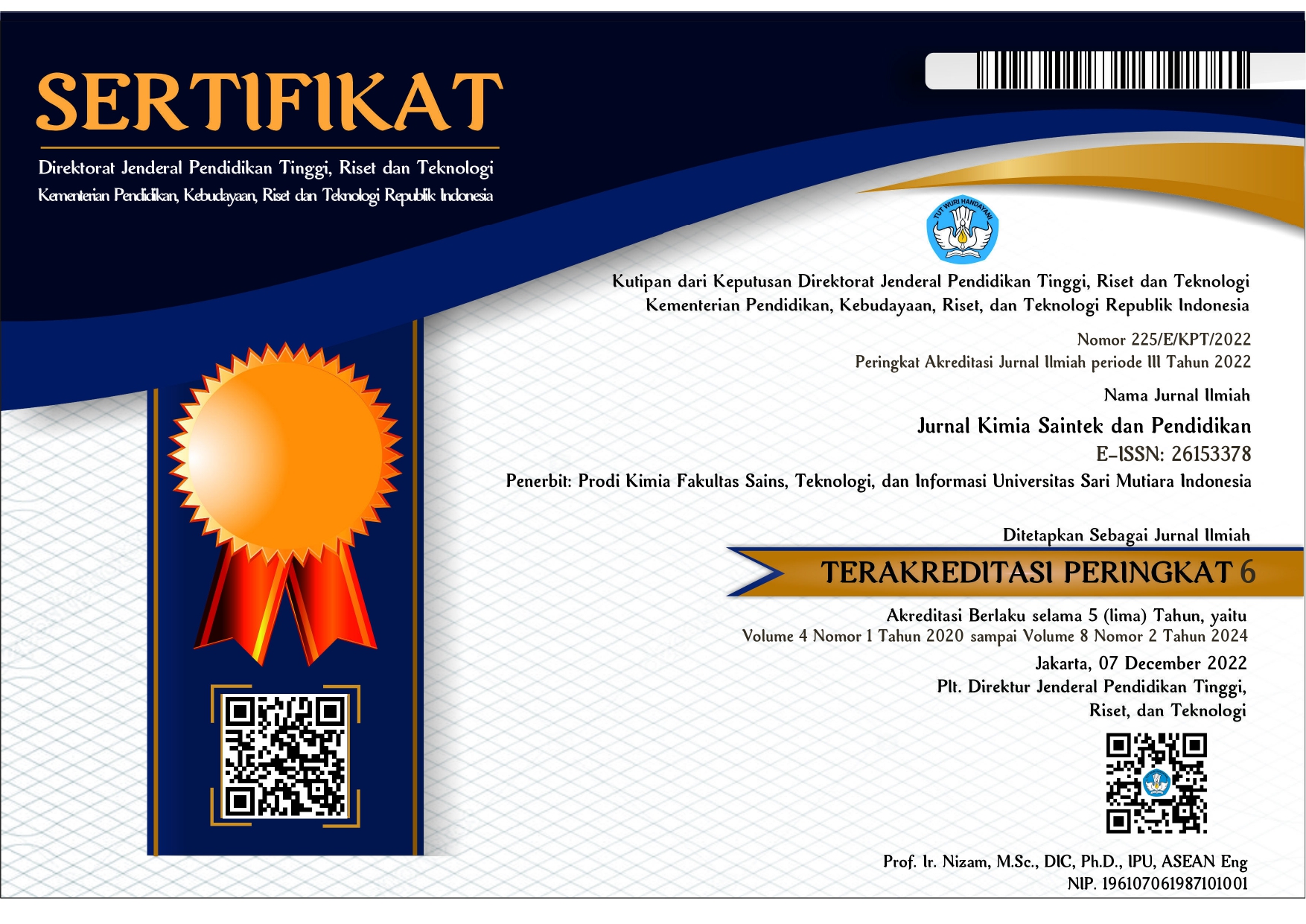PENENTUAN DISOLUSI PADA OBAT SENYAWA KETOPROFEN SECARA SPEKTROFOTOMETRI
DOI:
https://doi.org/10.51544/kimia.v7i1.3868Keywords:
buffer, dissolution, ketoprofen, spectrophotometryAbstract
Research on dissolution determination of Ketoprofen compounds by Spectrophotometry. Ketoprofen is a non-steroidal anti-inflammatory drug compound (NSAID) that works as an anti-inflammatory. Anti-inflammatory here is a group of drugs used to reduce inflammation and relieve pain. The dissolution test is a method used to determine the content of active compounds that dissolve in drugs, where the time, temperature and media are set according to the human stomach and intestines, and can find out how much the content of active compounds dissolves in the human intestines and stomach. This dissolution test, then the ketoprofen drug is read by spectrophotometry. Test the dissolution by spectrophotometer at a wavelength of 260 nm using HCl 0.1 N and buffer pH 7.4. The results of the determination of the dissolution test of the active substance on ketoprofen at the acid stage obtained an average of 0.009% and at the pH 7.4 buffer stage obtained an average content of 86.4155%. It can be concluded that the determination of the ketoprofen dissolution test in the sample meets the requirements (MS), in accordance with the specifications of the Internal Standard of PT Novell Pharmaceutical Laboratories, namely at the acid stage not more than 10% of ketoprofen dissolved in 2 hours, and at the pH 7.4 buffer stage it has a requirement of 75%. ketoprofen dissolved in 45 minutes. In the dissolution of acidic media, 0.1 N HCl is used because its condition resembles that of the stomach.
Downloads
References
Fudholi, A. 2013.Disolusi dan Pelepasan Obat in vitro. Yogyakarta: PustakaPelajaAssessment On Disolution Testing And Contrasting Models For Drugs. World Journal Of Pharmacy and Pharmaceutical Scieces. 3. (9): 865 – 895.
Bazzo,G.C., Lemos-Senna. E and Pires, A.T. 2009. Poly(3-hydroxybutyrate) /Chitosan/Ketoprofenor Piroxicam Composite Microparticles: Preparation and Controlled Drug Release Evaluation. Journal of Carbohydrate Polymers. 3. (77): 839 – 844.
Bhowmik, D., Gopinath, H., Kumar, B.P., Duraivel, S., Kumar, P.S., Kumar, K.P. 2012. Controlled release Drug Deivery System. The Pharma Innovation. 1. (10): 24 – 32.
Frizon, F., Eloy, J.O., Donaduzzi, C.M., Mitsui, M.L., Marchetti, J.M. 2013. Dissolution Rate Enhancement of Loratadine in Polyvinylpyrrolidone K30 Solid Dispersions By Solvent Metodes. Journal of Powder Technology. (235): 532 – 539.
Grimling, B., Gorniak, A., Meler, J., Maria., Pluta, J. 2014. Characterisation and Dissolution Properties of Ketoprofenin Binary Solid Dispersion with Chitosan. Journal of Pharmaceutical Technology. XIX. (4): 23 – 25.
Amien, Moh,.1997. Pedoman Laboratorium dan Petunjuk Praktikum PendidikanIPA Umum General Science LPTK. Jakarta: Depdikbud.
Harmita. 2006. Analisis Kuantitatif Bahan Baku dan Sediaan Farmasi Jakarta:Universitas Indonesia.
Holowka, E.P and Bhatia, S.K. 2014. Drug Delivery: Materials Design and Clinical Perspective. Science Media. New York. (17): 7 – 15.
ICH. (1994). ICH Harmonised Tripartite Guideline. Validation Of Analitycal Procedures: text and Methodology Q2(R1). The Textbook of Pharmaceutical Medicine,4(November), 447-460
Alagar R, Godavari S, David B, Selva K, Vanitha C. 2013. Analytical Development and Validation of Eperisone Hydrocloride and Diclofenac Sodium in Rapisone D SR Capsules by RP HPLC. J Adv Pharm Eduand Res.3(2): 61–66
Downloads
Published
Issue
Section
License
Copyright (c) 2023 Renny Futeri, Pevi Riani

This work is licensed under a Creative Commons Attribution-ShareAlike 4.0 International License.











.png)

